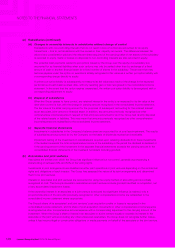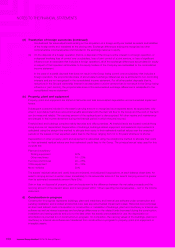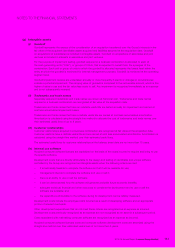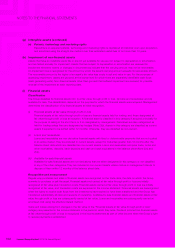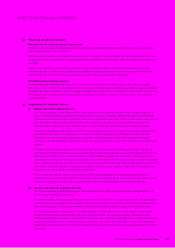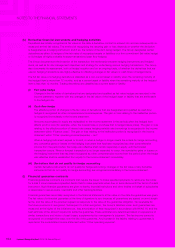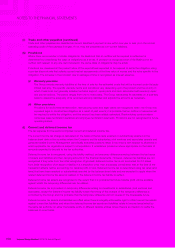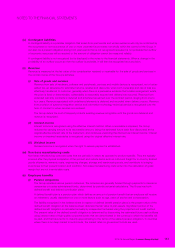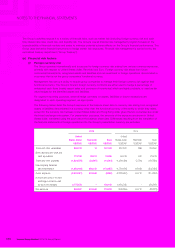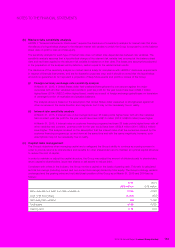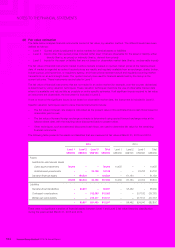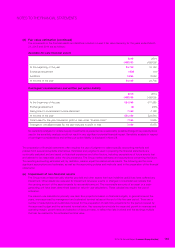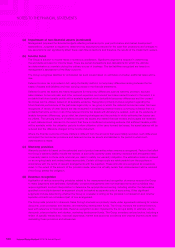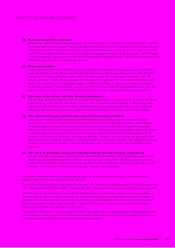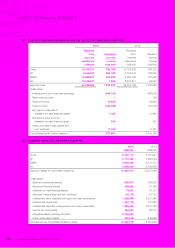Lenovo 2015 Annual Report Download - page 160
Download and view the complete annual report
Please find page 160 of the 2015 Lenovo annual report below. You can navigate through the pages in the report by either clicking on the pages listed below, or by using the keyword search tool below to find specific information within the annual report.
158 Lenovo Group Limited 2014/15 Annual Report
NOTES TO THE FINANCIAL STATEMENTS
2 SIGNIFICANT ACCOUNTING POLICIES (continued)
(x) Employee benefits (continued)
(i) Pension obligations (continued)
The current service cost of the defined benefit plan, recognised in the income statement in employee benefit
expense, except where included in the cost of an asset, reflects the increase in the defined benefit obligation
results from employee service in the current year, benefit changes, curtailments and settlements.
The net interest cost is calculated by applying the discount rate to the net balance of the defined benefit obligation
and the fair value of plan assets. This cost is included in employee benefit expense in the income statement.
Actuarial gains and losses arising from experience adjustments and changes in actuarial assumptions are
recognized as other comprehensive income/expense in the year in which they arise.
Past service costs are recognized immediately in the income statement.
A defined contribution plan is a pension plan under which the Group pays fixed contributions into a separate
entity. The Group pays contributions to publicly or privately administered pension insurance plans on a mandatory,
contractual or voluntary basis. The Group has no legal or constructive obligations to pay further contributions if the
fund does not hold sufficient assets to pay all employees the benefits relating to employee service in the current
and prior periods. The contributions are recognized as employee benefit expense when they are due and are
reduced by employer’s portion of voluntary contributions forfeited by those employees who leave the scheme prior
to vesting fully. Prepaid contributions are recognized as an asset to the extent that a cash refund or a reduction in
the future payments is available.
The Group’s contributions to local municipal government retirement schemes in connection with retirement benefit
schemes in the Mainland of China (“Chinese Mainland”) are expensed as incurred. The local municipal governments
in the Chinese Mainland assume the retirement benefit obligations of the qualified employees.
(ii) Post-employment medical benefits
The Group operates a number of post-employment medical benefit schemes, the largest being in the United
States. The entitlement to these benefits is usually conditional on the employee remaining in service up to
retirement age and the completion of a minimum service period. The expected costs of these benefits are accrued
over the period of employment using an accounting methodology similar to that for defined benefit pension
plans. Actuarial gains and losses arising from experience adjustments and changes in actuarial assumptions are
recognized as other comprehensive income/expense in the period in which they arise. The obligations of these
schemes in the United States are valued annually by independent qualified actuaries.
(iii) Long-term incentive program
The Group operates a long-term incentive program to recognize employees’ individual and collective contributions,
and includes two types of awards, namely share appreciation rights and restricted share units (“Long-term
Incentive Awards”). The Company reserves the right, at its discretion, to pay the award in cash or ordinary shares
of the Company. The fair value of the employee services received in exchange for the grant of the Long-term
Incentive Awards is recognized as employee benefit expense. The total amount to be expensed over the vesting
period is determined by reference to the fair value of the Long-term Incentive Awards granted, including any market
performance conditions (for example, an entity’s share price); excluding the impact of any service and non-market
performance vesting conditions (for example, profitability and sales growth targets); and including the impact of
non-vesting conditions. Non-market performance and service conditions are included in assumptions about the
number of Long-term Incentive Awards that are expected to become exercisable/vested. The total expense is
recognized over the vesting period, which is the period over which all of the specified vesting conditions are to be
satisfied.
At each balance sheet date, the Group revises its estimates of the number of Long-term Incentive Awards that are
expected to become exercisable. It recognizes the impact of the revision of original estimates, if any, in the income
statement, with a corresponding adjustment to share-based compensation reserve under equity.
Employee share trusts are established for the purposes of awarding shares to eligible employees under the long-
term incentive program. The employee share trusts are administered by independent trustees and are funded by
the Group’s cash contributions and recorded as contributions to employee share trusts, an equity component. The
administrator of the employee share trusts buys the Company’s shares in the open market for award to employees
upon vesting.
Upon vesting, the corresponding amounts in the share-based compensation reserve will be transferred to share
capital for new allotment of shares to employees, or to the employee share trusts for shares awarded to employees
by the employee share trusts.


